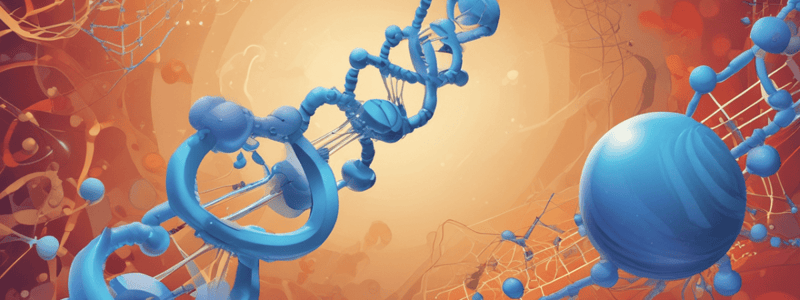Podcast
Questions and Answers
What is the term used to refer to the area on the enzyme where the substrate attaches?
What is the term used to refer to the area on the enzyme where the substrate attaches?
- Passive site
- Inactive site
- Active site (correct)
- Empty site
What is the term for the substance at the beginning of an enzymatic reaction on which an enzyme acts?
What is the term for the substance at the beginning of an enzymatic reaction on which an enzyme acts?
- Substrate (correct)
- Apoenzyme
- Prosthetic group
- Coenzyme
Which type of enzyme is inactive without its non-protein moiety?
Which type of enzyme is inactive without its non-protein moiety?
- Prosthetic group
- Apoenzyme (correct)
- Coenzyme
- Holoenzyme
What do we call a non-protein chemical compound tightly bound to an enzyme by covalent bonds?
What do we call a non-protein chemical compound tightly bound to an enzyme by covalent bonds?
What is the term for the special pocket or cleft in enzyme molecules where substrates bind?
What is the term for the special pocket or cleft in enzyme molecules where substrates bind?
What is the term for a group of enzymes that are active with their non-protein component?
What is the term for a group of enzymes that are active with their non-protein component?
What is the purpose of using 1-fluoro-2-4-dinitrobenzene in amino acid sequencing?
What is the purpose of using 1-fluoro-2-4-dinitrobenzene in amino acid sequencing?
What is the limitation of using the Sanger reagent in amino acid sequencing?
What is the limitation of using the Sanger reagent in amino acid sequencing?
What is the role of the phenylisothiocyanate reagent in Edman degradation?
What is the role of the phenylisothiocyanate reagent in Edman degradation?
What is the advantage of using Edman degradation over the Sanger reagent?
What is the advantage of using Edman degradation over the Sanger reagent?
What is the significance of determining the amino acid sequence of a polypeptide?
What is the significance of determining the amino acid sequence of a polypeptide?
Who is credited with the development of the Sanger reagent?
Who is credited with the development of the Sanger reagent?
What role do enzymes play in increasing reaction rates?
What role do enzymes play in increasing reaction rates?
Which model of enzyme action involves a flexible active site?
Which model of enzyme action involves a flexible active site?
What does the Lock-and-Key Model of enzyme action state about the relationship between active sites and substrates?
What does the Lock-and-Key Model of enzyme action state about the relationship between active sites and substrates?
Which type of enzymes show a greater range of substrate specificity according to the models discussed?
Which type of enzymes show a greater range of substrate specificity according to the models discussed?
When a substrate fits into an enzyme's active site, which complex is formed?
When a substrate fits into an enzyme's active site, which complex is formed?
What is the overarching effect of enzymes on reaction rates?
What is the overarching effect of enzymes on reaction rates?
What is the typical pH range at which most enzymes have an optimum pH?
What is the typical pH range at which most enzymes have an optimum pH?
Which factor can denature enzymes due to high values?
Which factor can denature enzymes due to high values?
What occurs when an enzyme reaches saturation with substrate molecules?
What occurs when an enzyme reaches saturation with substrate molecules?
Which of the following is an example of a cofactor for proper enzymatic activity?
Which of the following is an example of a cofactor for proper enzymatic activity?
What do competitive inhibitors do to enzymes?
What do competitive inhibitors do to enzymes?
In enzymatic reactions, what happens when the substrate concentration increases?
In enzymatic reactions, what happens when the substrate concentration increases?
What is the reagent that reacts with primary amino groups in both aliphatic and aromatic amines to produce stable blue- or blue-green fluorescent sulfonamide adducts?
What is the reagent that reacts with primary amino groups in both aliphatic and aromatic amines to produce stable blue- or blue-green fluorescent sulfonamide adducts?
Which enzyme cleaves peptide bonds on the carboxyl side of aromatic amino acids like Phenylalanine, Tyrosine, and Tryptophan?
Which enzyme cleaves peptide bonds on the carboxyl side of aromatic amino acids like Phenylalanine, Tyrosine, and Tryptophan?
What is the reagent that cleaves at tryptophan (Trp) residues?
What is the reagent that cleaves at tryptophan (Trp) residues?
Which enzyme breaks down collagen in meat, making it tender?
Which enzyme breaks down collagen in meat, making it tender?
What reacts with secondary amines and is more useful for samples containing brominated amino acids?
What reacts with secondary amines and is more useful for samples containing brominated amino acids?
What cleaves at the peptide bond on the carboxyl side of Arginine and Lysine?
What cleaves at the peptide bond on the carboxyl side of Arginine and Lysine?
Flashcards are hidden until you start studying



